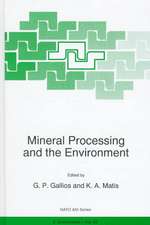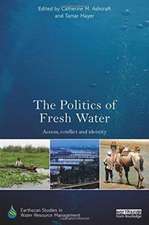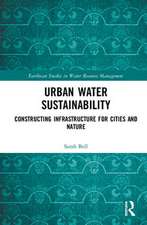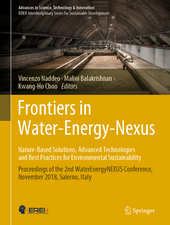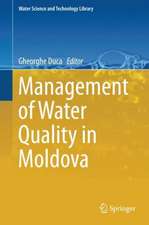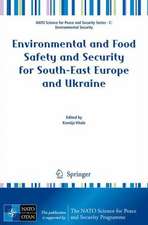Water Treatment Technologies for the Removal of High-Toxity Pollutants: NATO Science for Peace and Security Series C: Environmental Security
Editat de Miroslava Václavíková, Ksenija Vitale, G.P. Gallios, Lucia Ivanicováen Limba Engleză Paperback – 23 noi 2009
| Toate formatele și edițiile | Preț | Express |
|---|---|---|
| Paperback (1) | 1383.00 lei 6-8 săpt. | |
| SPRINGER NETHERLANDS – 23 noi 2009 | 1383.00 lei 6-8 săpt. | |
| Hardback (1) | 1227.36 lei 6-8 săpt. | |
| SPRINGER NETHERLANDS – 24 noi 2009 | 1227.36 lei 6-8 săpt. |
Din seria NATO Science for Peace and Security Series C: Environmental Security
- 18%
 Preț: 999.60 lei
Preț: 999.60 lei - 15%
 Preț: 659.70 lei
Preț: 659.70 lei - 18%
 Preț: 1106.00 lei
Preț: 1106.00 lei -
 Preț: 495.71 lei
Preț: 495.71 lei -
 Preț: 410.19 lei
Preț: 410.19 lei - 18%
 Preț: 1220.75 lei
Preț: 1220.75 lei - 18%
 Preț: 940.39 lei
Preț: 940.39 lei - 18%
 Preț: 1221.07 lei
Preț: 1221.07 lei - 18%
 Preț: 1232.71 lei
Preț: 1232.71 lei - 18%
 Preț: 1216.78 lei
Preț: 1216.78 lei - 18%
 Preț: 1818.02 lei
Preț: 1818.02 lei - 18%
 Preț: 1833.95 lei
Preț: 1833.95 lei - 18%
 Preț: 942.44 lei
Preț: 942.44 lei - 18%
 Preț: 1218.06 lei
Preț: 1218.06 lei - 15%
 Preț: 664.29 lei
Preț: 664.29 lei - 18%
 Preț: 1220.88 lei
Preț: 1220.88 lei - 24%
 Preț: 1040.01 lei
Preț: 1040.01 lei - 18%
 Preț: 1222.80 lei
Preț: 1222.80 lei - 18%
 Preț: 1220.75 lei
Preț: 1220.75 lei - 18%
 Preț: 1224.85 lei
Preț: 1224.85 lei - 18%
 Preț: 1231.47 lei
Preț: 1231.47 lei - 18%
 Preț: 1224.68 lei
Preț: 1224.68 lei - 18%
 Preț: 1224.85 lei
Preț: 1224.85 lei - 18%
 Preț: 963.15 lei
Preț: 963.15 lei - 18%
 Preț: 1229.10 lei
Preț: 1229.10 lei - 18%
 Preț: 1223.74 lei
Preț: 1223.74 lei - 18%
 Preț: 1213.65 lei
Preț: 1213.65 lei - 18%
 Preț: 956.33 lei
Preț: 956.33 lei - 18%
 Preț: 1235.43 lei
Preț: 1235.43 lei - 18%
 Preț: 940.39 lei
Preț: 940.39 lei - 18%
 Preț: 1210.63 lei
Preț: 1210.63 lei - 18%
 Preț: 1225.48 lei
Preț: 1225.48 lei - 18%
 Preț: 1234.14 lei
Preț: 1234.14 lei - 18%
 Preț: 1228.62 lei
Preț: 1228.62 lei - 18%
 Preț: 1222.94 lei
Preț: 1222.94 lei - 18%
 Preț: 962.98 lei
Preț: 962.98 lei - 18%
 Preț: 1218.06 lei
Preț: 1218.06 lei - 15%
 Preț: 643.99 lei
Preț: 643.99 lei - 18%
 Preț: 1222.49 lei
Preț: 1222.49 lei - 18%
 Preț: 1220.12 lei
Preț: 1220.12 lei - 18%
 Preț: 1233.52 lei
Preț: 1233.52 lei - 18%
 Preț: 946.24 lei
Preț: 946.24 lei - 18%
 Preț: 1218.21 lei
Preț: 1218.21 lei
Preț: 1383.00 lei
Preț vechi: 1686.58 lei
-18% Nou
Puncte Express: 2075
Preț estimativ în valută:
264.67€ • 273.05$ • 224.00£
264.67€ • 273.05$ • 224.00£
Carte tipărită la comandă
Livrare economică 05-19 martie
Preluare comenzi: 021 569.72.76
Specificații
ISBN-13: 9789048134960
ISBN-10: 904813496X
Pagini: 356
Ilustrații: X, 345 p.
Dimensiuni: 155 x 235 x 25 mm
Greutate: 0.5 kg
Ediția:2010
Editura: SPRINGER NETHERLANDS
Colecția Springer
Seria NATO Science for Peace and Security Series C: Environmental Security
Locul publicării:Dordrecht, Netherlands
ISBN-10: 904813496X
Pagini: 356
Ilustrații: X, 345 p.
Dimensiuni: 155 x 235 x 25 mm
Greutate: 0.5 kg
Ediția:2010
Editura: SPRINGER NETHERLANDS
Colecția Springer
Seria NATO Science for Peace and Security Series C: Environmental Security
Locul publicării:Dordrecht, Netherlands
Public țintă
ResearchCuprins
Nanomaterials for Chemical—Biological — Physical Integrity of Potable Water.- Rainwater Collecting as a Part of Implementation of the Sustainable Development Principles on Croatian Islands — Old Habits for New Era.- Fish Consumption and Mercury Body Burden in Women of Reproductive Age From Urban Area in Croatia.- Origin of Arsenic in Drinking Waters in the West Backa District of Serbia.- Magnetic Zeolite as Arsenic Sorbent.- Modeling and Simulation of Heavy Metals Removal From Drinking Water by Magnetic Zeolite.- Sorption of Metal Ions From Aqueous Solution on Fixed-Beds of Iron-Based Adsorbents.- Removal of Arsenic From Drinking Water — Croatian Experience.- Arsenic Oxidation by Membrane Contactors.- Arsenic Species Isoformation — A Key Problem for Water Purification.- Distribution and Speciation of Arsenic in Groundwaters and Tap Waters of Eastern Croatia.- Oxyanions in Waste: Occurrence, Leaching, Stabilisation, Relation to Wastewater Treatment.- Trace Elements Speciation in Mining Affected Waters.- Effect of Electrolytes on the Electrochemical Oxidation of Synthetic Dyes.- Heavy Metal Cationic Wastewater Treatment with Membrane Methods.- Separation of Cesium-137, Strontium-90 and Actinides from Waters and Wastewaters: A Short Review of the Materials and Processes.- Mo, Sb and Se Removal from Scrubber Effluent of a Waste Incinerator.- Equilibrium Modeling of Cu Removal From Aqueous Solutions: Influence of Ionic Strength.- Adsorption Characteristics of Cobalt(Ii) and Nickel(Ii) Onto Diatomite and Amberlite 252 Zu Resin from Aqueous Solutions.- Removal of Highly Toxic Wastewater Pollutants with Excessive Active Sludge.- Analysis of Influence of the Thermal Power Plant Wastewaters Discharge on Natural Water Objects.- Extraction of Nickel and Copper Ions fromWaste Technological Solutions.- Composite Iron-Based Coagulant Synthesised by Inorganic Polyferric Sulphate and Organic, Non-Anionic Polymer.- Characterization and Application of Novel Coagulant Reagent (Polyaluminium Silicate Chloride) for the Post-Treatment of Landfill Leachates.- Application of Carbon Nanoparticles for Water Treatment.- Sorption of Copper and Zinc Cations by Bio-Modified Brown Coal.- Application of Bacterially Produced Hydrogen Sulphide for Selective Precipitation of Heavy Metals.- Morphology Control of Ordered Porous Silica Adsorbents.- Chemical Modification of Silica Surface by Immobilization of Amino Groups for Synthesis of Silver Nanoparticles.- Removal of Nickel by Natural and Magnetically Modified Bentonite.- Effect of Magnetic Modification on the Sorption Properties Of Natural Bentonite.- New Chemical Sensors for Fast and Reliable Analytical Control of Sn2+ and Pb2+ Ions in Water and Waste Water.- Express Uv-Photometry Method for Determination of the Oil-Compounds Content in Water.- Optimal Synthesis of System for Thermal Treatment of Chlorine Water.- Research in the Institute of Geotechnics Sas — Water Treatment Technologies.
Caracteristici
The book will be a considerable value as a secondary text for universities currently offering courses in water treatment and environmental technologies Constitutes a valuable source of information on high-toxicity pollutants in the environment, their health effect to human beings, speciation of toxic species in aqueous systems, removal techniques, legislation and maximum contaminant limits



